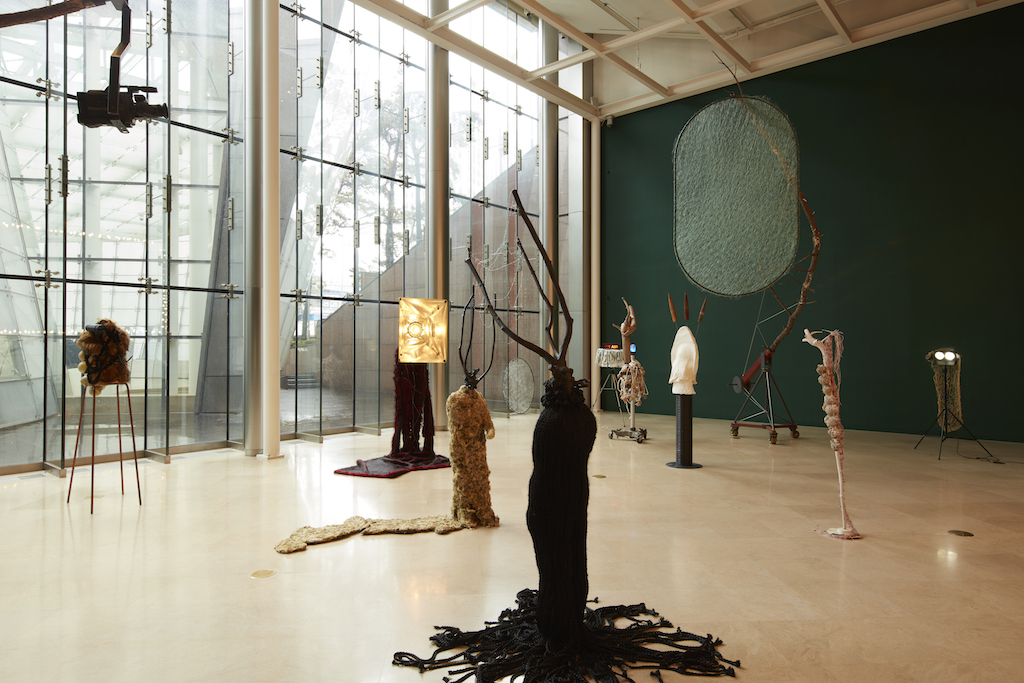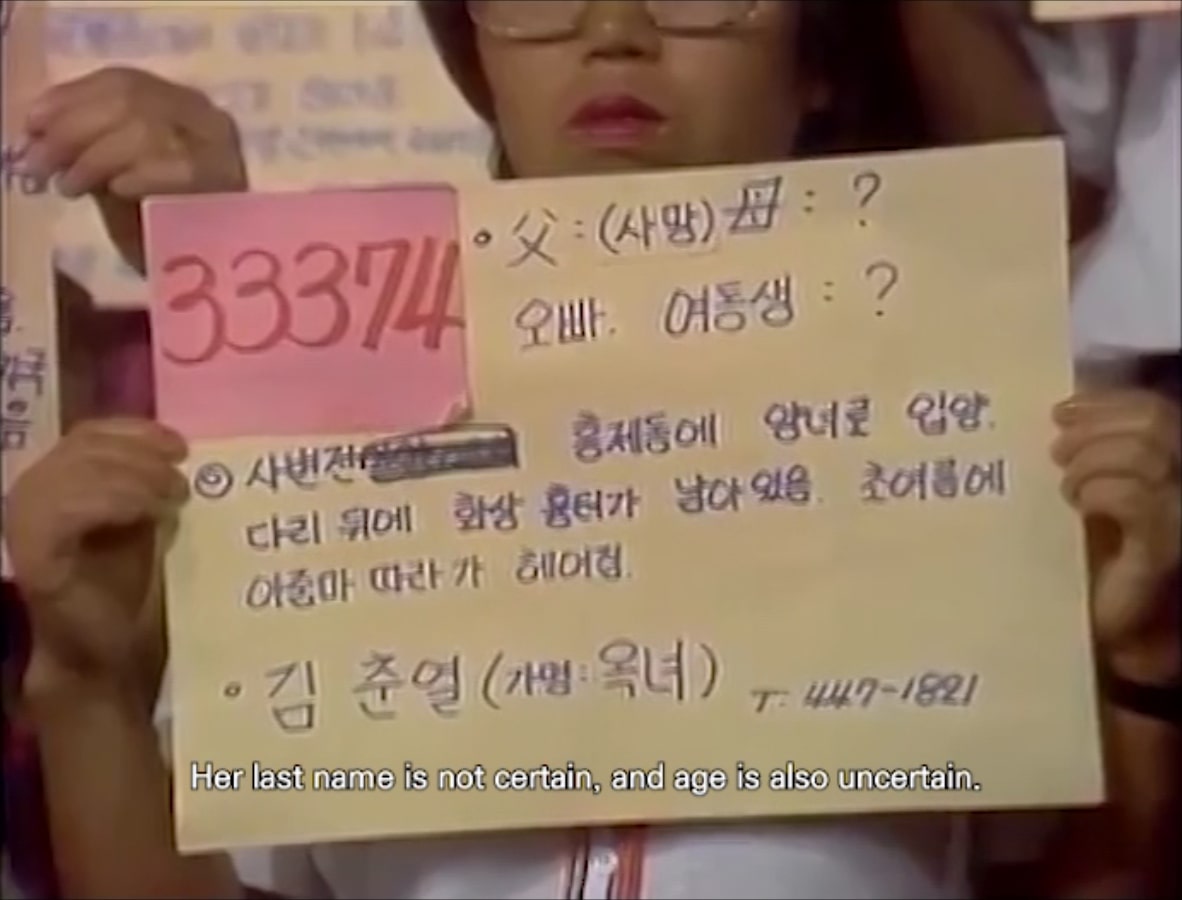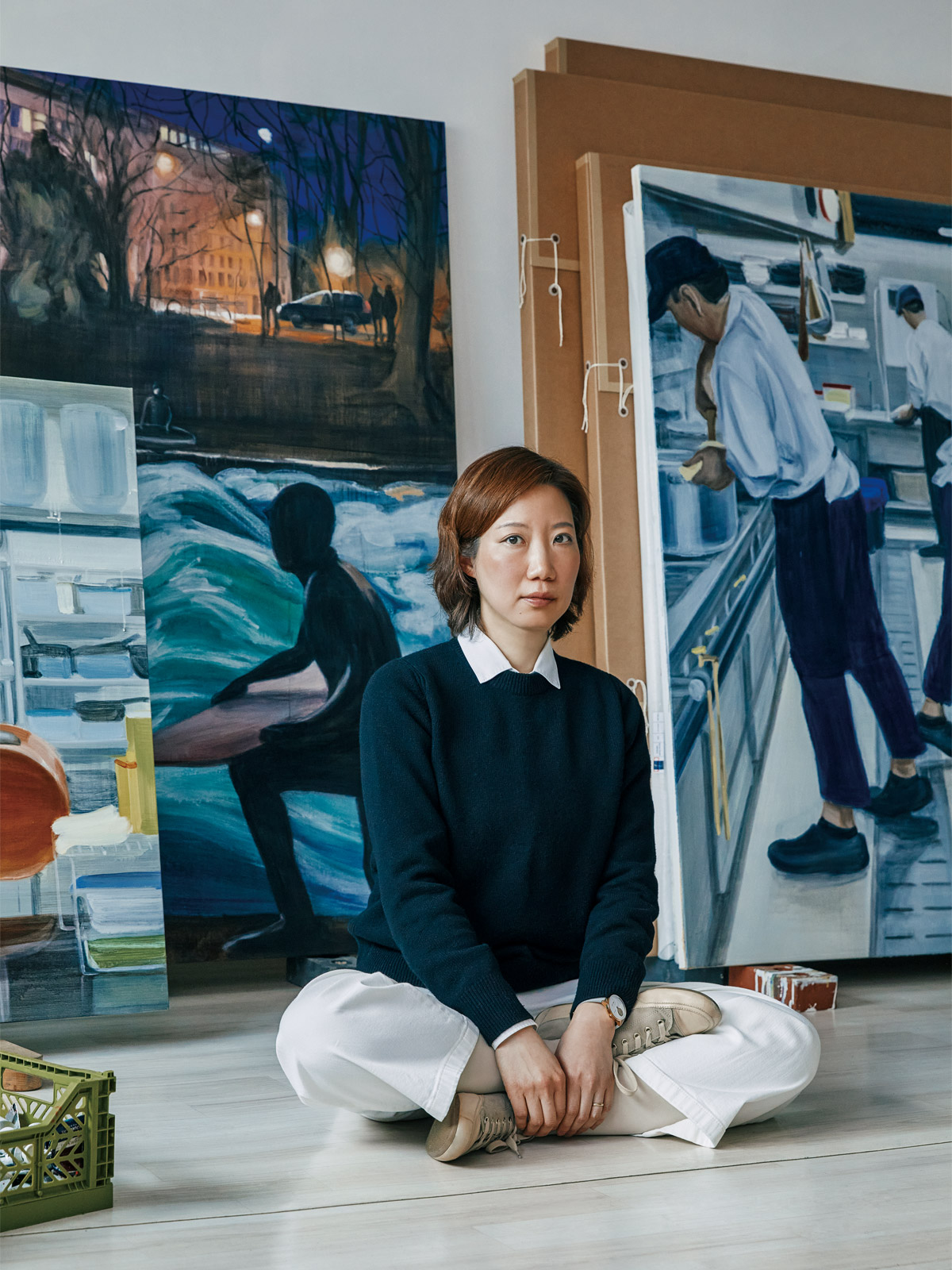Minouk Lim
(b.1968) has gained international recognition for her
sharp observations of the turbulent cultural, economic, and political dynamics
in Korean society amidst the rapidly restructured currents of modernization and
globalization, through her works that transcend the boundaries of various
media.
From fluid and fragile materials, sounds
that flow and disappear, videos that oscillate between fact and fiction, to
performances completed by the assembly of body and voice, and works where
entirely different media translate one another—through these diverse forms, she
attempts a redistribution of the sensory, vividly revealing forgotten and
hidden voices and figures.

Minouk Lim, Rolling Stock, 2000 ©Minouk Lim
After completing her studies in
France, Lim formed a collective called “Pidgin Girok” with Frederic Michon and
produced Rolling Stock (2000). Created with the intention of
“continuously rolling to bring things to life,” Rolling Stock
consists of two versions: a booklet and a single-channel video.
Initially produced as a kind of culture
guidebook for foreign visitors to the Gwangju Biennale, the project took the
form of a booklet. Three years later, it was invited to an exhibition
commemorating diplomatic ties with the Netherlands, where the medium was
shifted from book to video, once again “re-rolling” the images. Rolling
Stock traces and visually reconstructs things that disappear in the
fast-paced flow of the city, capturing and accumulating fleeting moments to
revive them.

Minouk Lim, New Town Ghost, 2005 ©Minouk Lim
As seen in Rolling Stock,
Lim's early works focus on the environment of the "city." After the
Yeongdeungpo district, where she lived and worked, was designated as a
"New Town" for urban redevelopment, she created the performance video
New Town Ghost (2005) set against this backdrop.
In the video, a young woman with short
hair and heavy makeup sings a song titled "New Town Ghost Song,"
which the artist composed, while standing on top of a truck driving through the
streets of Yeongdeungpo. The video alternates between scenes of the woman
passionately singing into a megaphone to the beat of drums, almost angrily, and
the bewildered faces of citizens watching her from the street. Through works
like this, Lim has consistently explored the memories of urban redevelopment
and the resulting damage, bringing attention to these issues in her art.

Minouk Lim, S.O.S. – Adoptive Dissensus, 2009 ©Minouk Lim
In Lim’s early works, live
performances in urban spaces often intersected with the reactions of passersby,
creating more dramatic situations. This approach became more nuanced in her
2009 three-channel video work, S.O.S. – Adoptive Dissensus,
where performance and documentary elements intersect.
S.O.S. – Adoptive Dissensus
is a video piece that captures performances both inside and outside a Han River
cruise ship, onto which the audience was invited. The work weaves together
theatrical performances that discuss themes of development, preservation,
humanity, and the city. Passengers on the cruise encounter various staged
scenes: the captain’s speech, protestors with mirrors placed at specific
locations along the riverbank, performances by drifting couples, and the voice
of a unconverted long-term political prisoner under surveillance.

Minouk Lim, S.O.S. – Adoptive Dissensus, 2009 ©Minouk Lim
During
the performance, lights installed on the cruise ship illuminate various parts
of the riverside, including apartment buildings, large skyscrapers, and
construction sites. The audience oscillates between being objects and subjects
of the performance, and the multisensory experience they undergo becomes a key
part of the artwork.
The
artist explains, “This performance raises questions about the relationship
between speed and memory, resistance to it, and the relationship between humans
and nature within the city.” On the moving cruise ship, the audience is no
longer just passive spectators. They are actively immersed in the social and
historical contexts of the Han River, experiencing the questions posed by the
artist in a sensory, participatory way.
 Minouk
Lim, International Calling Frequency, 2011 ©MMCA
Minouk
Lim, International Calling Frequency, 2011 ©MMCAIn 2011, Lim collaborated with artists
from different genres and ordinary citizens to create International
Calling Frequency. This work was set against the backdrop of the
Myeong-dong Central Theater area, which was then facing redevelopment, with
local shops under threat of demolition and protests against the demolitions
taking place.
Lim collaborated with Minwhee Lee from
the band ‘Mukimukimanmansu’ to compose a song, which was then taught to people
who had been recruited to participate. Those who learned the song went out into
the streets to perform it. The song, without lyrics, became a kind of wave
transmitted to those displaced from their homes and places of livelihood,
resonating through the city as a voice for the powerless.

Minouk Lim, Running on Empty, 2015, Installation view of “The Promise of If” (Samsung Museum of Art, PLATEAU, 2015-2016) ©Minouk Lim
Through her work, Lim addresses the
marginalized and overlooked places and people, forgotten lives and memories
within the context of rapid urban modernization in Korean society, blending
performance and documentary. She continues to explore themes of mourning and
memory restoration not only through video media but also through sculptural
work.
In her solo exhibition “The Promise of
If” held at the Samsung Museum of Art, PLATEAU in 2015, she presented Running
on Empty, which utilized materials often overlooked in art, such as
liquids, latex, candle wax, feathers, bone fragments, and residues, to shape
ephemeral organic presences. By incorporating multisensory elements like sound,
light, and temperature, the work transcends the material properties of the
substances used, extending into the emotional resonance of grief and mourning.
 Minouk Lim, It’s
a name I gave myself, 2018 ©Minouk Lim
Minouk Lim, It’s
a name I gave myself, 2018 ©Minouk LimLim also showcased a video work at her
exhibition at PLATEAU that reexamines the phenomenon of the Korean diaspora by
referencing the 1983 KBS program ‘Finding Separated Families.’ This work later
evolved into a piece titled It’s a name I gave myself in
2018.
The artist reflected on the moments
when families were reunited during the television program, which aimed to
reconnect families torn apart by the Korean War over a span of 138 days. On
being faced with these scenes, Minouk Lim saw the space of the broadcast as a
place for conversations that bring back the memories and history that we have
forgotten. This moment raised fundamental questions in her mind about the
function, role, possibilities, and superficiality of media, becoming an
unforgettable "event" etched into her memory.

Left) Minouk Lim, Black Hole, 2015, Installation view of “Checkpoint: Border Views from Korea” (Kunstmuseum Wolfsburg, 2022) ©REAL DMZ PROJECT. Photo: Marek Kruszewski
Right) Minouk Lim, It’s a name I gave myself, 2018, Installation view of “Checkpoint: Border Views from Korea” (Kunstmuseum Wolfsburg, 2022) ©REAL DMZ PROJECT. Photo: Marek Kruszewski
In her work, Minouk Lim interpreted this situation as the public service broadcaster, which had served on the front line of the government’s propaganda war, being occupied by many people whose families were separated by the Cold War and had to live in silence. The single-channel video work It’s a name I gave myself primarily captures the reunions of separated families, focusing on individuals who lost their families at such a young age that they can no longer even remember their own names.
 Installation view
of “Minouk Lim: Memento Moiré” (BB&M, 2024) ©BB&M
Installation view
of “Minouk Lim: Memento Moiré” (BB&M, 2024) ©BB&MThis year, Lim showcased her work in the solo exhibition “Memento Moiré” at BB&M, where she expanded her artistic world into abstract and symbolic dimensions such as myth, ritual, and totem, transcending the boundaries of specific places and times. Notably, her new series of paintings employs materials that she has primarily used in the past, such as polyurethane and bone fragments, to express themes related to cosmology, mystical iconography, and the remnants of nature and civilization.
 Minouk
Lim, Almost Too Calm 1, 2024 ©BB&M
Minouk
Lim, Almost Too Calm 1, 2024 ©BB&MFor instance, the series Almost
Too Calm (2024) features works that depict everyday objects that have
served their purpose, such as cuttlefish bones, barnacle shells, dried seaweed,
camera straps, and roller shade pulley, as if they are preserved under a
transparent layer of polyurethane. This form of embedding the remnants of
nature and civilization prompts viewers to imagine a future museum that preserves
the legacies of extinct cultures.
Through various media and
materials—video, sculpture, and everyday objects—Minouk Lim’s work evokes the
scars left by the ideological divisions of the Cold War and the underlying
rapid social changes, continually re-rolling these obscured or omitted, ghostly
presences back to life. Additionally, she imagines the existence of non-human
witnesses and calls forth forgotten things in new ways through the connections
among active objects.
“My work throws the question on the
relationship of memory faded by speed, resistance from it and the relationship
between human beings and nature inside the city.
This rapidly changing environment
erases our memories and we have to prepare ourselves to let go of the memories
without making them. The dizzy process of ‘globalization’ seems as though ‘we
have already seen it’ and ‘we have already lost it,’ while wondering about the
restless time.”

Artist Minouk Lim ©BB&M
Minouk Lim holds a Diplôme National
Supérieur d'Arts Plastiques (DNSAP) from École Nationale Supérieure des
Beaux-Arts de Paris. Lim has been the subject of solo exhibitions and projects
at such important institutions as the National Museum of Modern and
Contemporary Art, Seoul (2018); Centre Pompidou, Paris (2017); PLATEAU, Samsung
Museum of Art, Seoul (2015); Portikus, Frankfurt (2015); Walker Art Center,
Minneapolis (2012); and the National Museum of Asian Art, Smithsonian
Institution, Washington, DC (2011).
Her work has been included in group
exhibitions at museums throughout the world, including Schirn Kunsthalle,
Frankfurt (2022); MAXXI, Rome (2019); Museum of Contemporary Art, Tokyo (2015);
and Kunsthalle Wien (2015). She has also participated in numerous international
biennials, including Gwangju (2021, 2014, 2008, 2006), Lyon (2019), Sydney
(2016), Liverpool (2010), and Istanbul (2007), as well as in the Asia Pacific
Triennial, Brisbane (2021) and the Paris Triennale (2012).
She is the recipient of the Obayashi
Foundation Research Program grant in 2023. She was also honored with the 2024
Asia Arts Game Changer Award presented by Asia Society New York.
References
- 임민욱, Minouk Lim (Artist Website)
- BB&M, 임민욱 (BB&N, Minouk Lim)
- 올해의 작가상, 임민욱 (Korea Artist Prize, Minouk Lim)
- 서울시립미술관, S.O.S. – 채택된 불일치, 2009, 임민욱 (Seoul Museum of Art, S.O.S. - Adoptive Dissensus, 2009, Minouk Lim)
- 국립현대미술관, 임민욱 | 국제호출주파수 | 2011 (National Museum of Modern and Contemporary Art Korea (MMCA), Minouk Lim | International Calling Frequency | 2011)
- 리얼디엠지프로젝트, [RDP 2022 / Artist] 임민욱 (REAL DMZ PROJECT, [RDP 2022 / Artist] Minouk Lim)
- BB&M, 임민욱: Memento Moiré (BB&M, Minouk Lim: Memento Moiré)





















